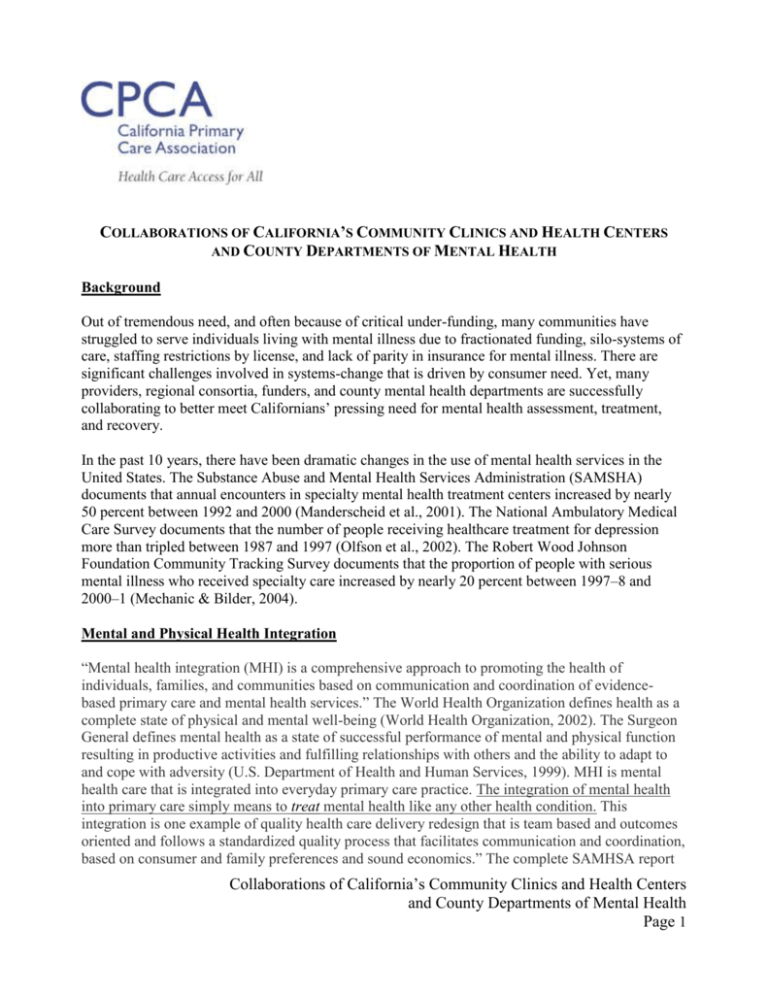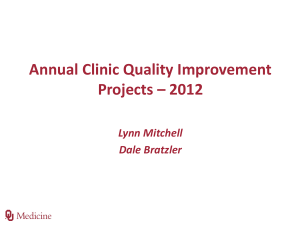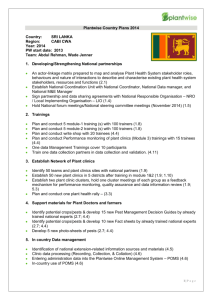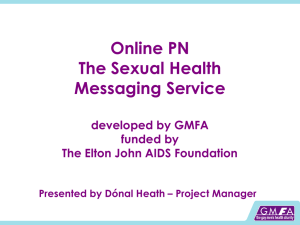CCHC and County Department Of Mental Health
advertisement

COLLABORATIONS OF CALIFORNIA’S COMMUNITY CLINICS AND HEALTH CENTERS
AND COUNTY DEPARTMENTS OF MENTAL HEALTH
Background
Out of tremendous need, and often because of critical under-funding, many communities have
struggled to serve individuals living with mental illness due to fractionated funding, silo-systems of
care, staffing restrictions by license, and lack of parity in insurance for mental illness. There are
significant challenges involved in systems-change that is driven by consumer need. Yet, many
providers, regional consortia, funders, and county mental health departments are successfully
collaborating to better meet Californians’ pressing need for mental health assessment, treatment,
and recovery.
In the past 10 years, there have been dramatic changes in the use of mental health services in the
United States. The Substance Abuse and Mental Health Services Administration (SAMSHA)
documents that annual encounters in specialty mental health treatment centers increased by nearly
50 percent between 1992 and 2000 (Manderscheid et al., 2001). The National Ambulatory Medical
Care Survey documents that the number of people receiving healthcare treatment for depression
more than tripled between 1987 and 1997 (Olfson et al., 2002). The Robert Wood Johnson
Foundation Community Tracking Survey documents that the proportion of people with serious
mental illness who received specialty care increased by nearly 20 percent between 1997–8 and
2000–1 (Mechanic & Bilder, 2004).
Mental and Physical Health Integration
“Mental health integration (MHI) is a comprehensive approach to promoting the health of
individuals, families, and communities based on communication and coordination of evidencebased primary care and mental health services.” The World Health Organization defines health as a
complete state of physical and mental well-being (World Health Organization, 2002). The Surgeon
General defines mental health as a state of successful performance of mental and physical function
resulting in productive activities and fulfilling relationships with others and the ability to adapt to
and cope with adversity (U.S. Department of Health and Human Services, 1999). MHI is mental
health care that is integrated into everyday primary care practice. The integration of mental health
into primary care simply means to treat mental health like any other health condition. This
integration is one example of quality health care delivery redesign that is team based and outcomes
oriented and follows a standardized quality process that facilitates communication and coordination,
based on consumer and family preferences and sound economics.” The complete SAMHSA report
Collaborations of California’s Community Clinics and Health Centers
and County Departments of Mental Health
Page 1
is available at: Mental Health, United States 2004:
http://mentalhealth.samhsa.gov/publications/allpubs/SMA06-4195/default.asp
Today, the responsibility for providing mental health care falls increasingly to primary care
providers. Both consumer preference and economic disincentives are driving the need for reform of
a fragmented mental health system. In the past decade there has been a significant increase in the
proportion of people with serious mental illness and substance abuse disorders who report receiving
care from primary care providers and hospital emergency rooms (Kessler et al., 2005; Reiger et al.,
1993).
By 2020, depression and mental disorders are projected to rank second only to cardiovascular
illness as the worldwide leading cause of disability (Murray & Lopez, 1996). Despite the
availability of evidence-based treatment for mental disorders, many patients and families do not
receive effective treatment (Eisenberg, 1992; Kessler et al., 2005; Wang, Demler, & Kessler, 2002;
Whooley & Simon, 2000; Young et al., 2001). Ethnic minorities, older patients, and less educated
patients are more likely to be subject to treatment disparities and to receive lower quality care than
other depressed patients (Melfi et al., 2000; Miranda, 2004; U.S. Department of Health and Human
Services, 1999; Young et al., 2001).” (Brenda Reiss-Brennan, M.S.N., Intermountain Health Care)
“Most people see their primary care provider, including CCHCs, about 4 times a year, allowing for
monitoring and treatment of co-existing conditions.” (K. Strosahl PhD, CPCA FACT SHEET).
CCHC Mental Health Services
The California Primary Care Association (CPCA) represents more than 650 community clinics and
health centers (CCHCs) that provide comprehensive primary and preventative health care services
to 3.6 million low-income, ethnically diverse patients of which 49% are limited English proficient
and 82% have incomes under 200% of the federal poverty level.
It is estimated that 6,774,330 to 10,161,494 (20-30%) of California’s total population (33,871,648;
U.S. Census) has a diagnosable mental illness which has a tremendous impact on this populations’
lives, families and workplaces; on counties’ Departments of Mental Health Services, and on CCHCs
and emergency rooms:
Of those suffering from a diagnosable mental illness, more than 50% never seek help (K.
Strosahl, Ph.D).
While asked to serve the entire Medi-Cal population, counties’ mental health systems “serve
only 1.4% to 2.1% of the population, while diagnosable mental illness affects 25% of the
population” (CIMH, CMHDA, NSRHN Coordinating for Care, 2002). Under-funding is a
critical factor affecting this statistic a counties must prioritize the distribution of their limited
resources.
Ninety percent of primary care clinicians report providing mental health services to
California’s 794 CCHCs. Annually, 230 of the CCHCs site that provide mental health
services report 809,928 mental health encounters, with 553,283 of those encounters
provided by mental health professionals and the remaining visits provided by primary care
providers (CPCA Fact Sheet).
Collaborations of California’s Community Clinics and Health Centers
and County Departments of Mental Health
Page 2
Primary care providers (including CCHC’s) prescribe 67% of all psychoactive agents and
80% of all antidepressants (CPCA Fact Sheet, K. Strosahl, PhD). As a first line of defense in
prevention and early detection and treatment, there is no larger assessing and prescribing
body currently available other than primary care providers {in assessing and treating mental
illness} (CPCA Fact Sheet).
A wide variety of communities, government agencies, non-profits, etc., is typically involved in
efforts to provide (successful) access to mental health services. CPCA, clinic consortia (local or
regional collaborations linked together to solve common critical safety-net service delivery barriers
and manage resources), providers, hospitals and community-based non-profits are vital partners for
counties and consumers interested in addressing access and quality of care for behavioral health
consumers.
CCHC and County Department of Mental Health Collaboration Models
Why is collaboration between county mental health departments and community clinics such an
important element in improving mental health services in every community? In an effort to answer
that question, CPCA asked CCHCs with innovative programs to share their successful collaborative
models with replicable service strategies aimed at addressing and/or meeting consumer’s needs.
Also noted in the profiles are of the counties’ successes resulting from community-wide
collaborations. The information was graciously provided from a variety of sources: individual
CCHCs, regional consortia, county departments of mental health, and the Integrated Behavioral
Health Project. CPCA greatly appreciates leadership and vision of those individuals that provided
information to us so that we can distribute it widely.
The CCHC and county department of mental health collaborations profiled, Alameda, Humboldt,
Kern, Los Angeles, Nevada, San Diego, and Shasta have the following common traits:
Access to care for all regardless of ability to pay
Training, cross-training, shared training, and additional training
Consultative and/or direct psychiatric care; assistance to primary care providers in
diagnosing, treating and prescribing medications for their patients with mental illness; and
consistency in building their psychiatric diagnostic and treatment skills
Use of innovative practices such as telepsychiatry, integrated primary behavioral health
care/mental health integration, promotores and case managers, home visitors, homeless
programs, mobile vans, and many other innovations required to link necessary services to
people in need
Cultural and linguistic competencies
Minimization of stigma
Significant commitment to holistic health, population-based care, and client-centered
Universal assessment for mental illness using a variety of tools that can be re-administered
over time to track outcomes
Collaborative community culture
Collaborations of California’s Community Clinics and Health Centers
and County Departments of Mental Health
Page 3
CCHC and County Department Of Mental Health Collaborations Profiles
Alameda County
County Population: 1,496,968
Numbers served at County Mental Health: Not available
Numbers Served at CCHCs: 115,000 unduplicated patients. In 2004, 81,850 patients with 1
ambulatory care visit at a community clinic were studied. Initial findings indicate that 10,403 (13%)
of patients served at community clinics had at least one mental health diagnosis.
Featured CCHCs: Lifelong Medical (LM) and Asian Health Services (AHS)
Regional Consortia: Alameda Health Consortium (AHC)
Overview (Pre and Post Mental Health Services Act (MHSA): Prior to the MHSA, a
collaborative relationship with Alameda County was already in place. This collaborative culture has
allowed for a true commitment to providing mental health services, including strong advocacy
efforts and the integration of primary behavioral health care that is both age and ethnically diverse an appropriate focus of MHSA planning.
Best Practices: Alameda Older Adults Program at LM and Project Respect at AHS are two “best
practice” programs within the county. Other best practices include quarterly meetings between the
county DMH and consortium members; access to county DMH training regarding how to access
DMH’s services including psycho-pharmacology training for clinic physicians; a Consortia Mental
Health Peer Group; use of psychiatrists on staff; and cultural and linguistic expertise. Lifelong
Medical’s “Over 60 Berkeley Clinic’s Mental Health Services Program” has 11 staff members
consisting of case managers, one LCSW, one MSW (not yet licensed), a geriatric psychologist and a
geriatric psychiatrist. Mental health services are integrated with psychosocial and medical services.
The program offers individual psychotherapy, group sessions, substance abuse counselors and
medication treatment. No-cost patient medication programs are also a part of community clinic’s
services. Lifelong Medical also has integrated primary behavioral health care available for all,
including a supportive housing program.
Contracts: Contracts are with the county DMH as a network - one large, central contract held by
the consortium for mental health services for the senior population and implemented at a number of
the clinic’s sites. For the purpose of hiring more bilingual staff, clinics in Alameda County have
also contracted directly with MHSA for funding. Additionally, Alameda Health Consortium’s
member clinics have contracts with their county’s Behavioral Health Department.
Funding Sources: The AHC was successful in obtaining buy-in from stakeholders and the county,
whom all agree that integration of primary care and mental health is critical. The Consortia’s
biggest financial success was obtaining approximately $1 million dollars for integrating primary
care and mental health services for their senior population. Additional funding for these programs
includes a combination of Medi-Cal reimbursement, the Bureau of Primary Care’s expansion grant,
CMSP, sliding scale, self-pay, and private grant funding.
Collaborations: Partnering with the mental health contractor network for planning, sub-contracting
and support for primary care integration, the AHC is serving on the County MHSA Steering
Committee and other related committees. The AHC obtained a seat on the Alameda County
Collaborations of California’s Community Clinics and Health Centers
and County Departments of Mental Health
Page 4
Stakeholder Group - the advisory body to the County Board of Supervisors. One program in
particular, The Project Respect-The Frequent Users Project, is highly collaborative.
Innovations: Alameda is a very forward-thinking, managed care, county. Clinics and Consortia sit
on the MHSA planning council. Planning efforts include Consortium advocacy for the following
key principles:
Integrating mental health and primary care
Reducing racial and ethnic health disparities
Promoting cultural and linguistic competency
Addressing all areas of the county
Focusing on prevention to reduce crisis and institutionalism
Focusing on real change/transformation in the mental health system.
There is a strong consumer focus, including having family representatives of mental health
consumers/patients on staff at the AHC. Innovative consumer collaborations include: Alameda
County Council of Community Mental Health Agencies (ACCMHA) and their member
organizations, such as Bonita House. Highly innovative, AHS’ behavioral health team has language
capacity in Cantonese, Mandarin and Taiwanese. Interpreters are used for patients that speak other
Asian/Pacific Island languages to not only provide competent care, but to engage
consumers/patients and communities in building trust and support for advocacy efforts, including
gathering accurate information from consumer focus groups. The AHS behavioral health team
provides a teen evening clinic that involves not only behavioral health staff, but also peer
counselors, as well as a high risk prenatal program whereby a social worker works with high risk
obstetrics patients regarding psycho-social issues.
Humboldt County
County Population: 128,376
Numbers served at County Mental Health: Not available
Numbers Served at CCHCs: Of Open Door Community Health Centers’ (ODCHCS) 10 clinic
sites, four offer mental health services. Additionally, ODCHC collaborates with two other
community clinics in the county, Mobile Medical Office and Redwoods Rural Health Center.
Together, these six sites provided 145,447 encounters for 42,935 patients in 2005. Through the use
of integrated mental health services such as the use of universal assessments tools for mental illness,
9,488 of the total encounters at the community clinics were mental health visits provided by a
Licensed Clinical Psychologist, LCSW, MFT or a substance abuse counselor. As well as the four
clinics sites, ODCHC has recently added a Telehealth & Visiting Specialist Center that offers
psychiatric consultations via telemedicine.
Featured CCHC: Open Door Community Health Centers
Regional Consortia: North Coast Clinics Network
Overview (Pre and Post MHSA): Open Door Community Health Centers was a pioneer in
integrated primary behavioral health care. ODCHC worked with Kirk Strosahl, Ph.D., to create a
policies and procedure manual that has been used as a nationwide model for other clinic’s manuals.
ODCHC has met considerable challenges including an early systems change and billing and staffing
issues; however, they remain committed to meeting the need for holistic, integrated primary
behavioral health care in Humboldt County. ODCHC’s pre-MHSA relationship with Humboldt
Collaborations of California’s Community Clinics and Health Centers
and County Departments of Mental Health
Page 5
County DHHS was characterized by differences in individual issues of care and 5150 (crisis)
response. Both the County and ODCHC committed to a long process of trust building and “walking
in each other’s moccasins” as ODCHC Executive Director, Hermann Spetzler, described it. Rather
than complain about the lack of resources, the county and ODCHC instituted quarterly meetings to
discuss available resources and enhance mutual understanding. The organizations recognized there
were “limited resources and unlimited need.” There was a tremendous learning curve on both sides,
but now the clinic is managing a much higher acuity of client/patients, thus freeing up resources for
crisis care at the county level. Open Door stresses the importance of a strong, client-focused
commitment to access to care and collaborative plans, despite sometimes critical challenges in
staffing, funding, and connectivity.
Best Practices: Universal assessment of patients, telepsychiatry, quarterly meetings to share
information and case studies, use of the Four Quadrant model that effectively “stages” client’s
recovery and targets levels of care, and shared psychiatric support from the county to the clinics. IT
and use of telemedicine have all improved client care and individual outcomes as well as forging a
more collaborative system with a common language (Four Quadrants) to clarify when a client can
benefit from medication management and case management at the clinic level and when they might
need intensive, crisis, or chronic high level care from the county.
Contracts: The clinics currently have a Memorandum of Understanding with the county for their
telemedicine and telepsychiatric collaboration.
Funding Sources: Total Clinic Funding (OSHPD 2005)
Net Patient Revenue
67.66%
Federal Grants
15.89%
State Grants
7.36%
County or Local Funds
0.76%
Local
0.29%
Private Foundations
1.74%
Donations and Other
6.31%
Other
2.03%
Collaborations: North Coast Clinics Network convenes a quarterly meeting between Humboldt
County Department of Health and Human Services (DHHS) and CCHC executive directors to
discuss community-related mental health issues. In addition to their participation at the quarterly
DHHS meetings, Sally Hewitt, Executive Director of MMO, and Eric Fimbres, Executive Director
of RRHC, have seats on the Humboldt County Mental Health Board. Fimbres also sits on the
Mental Health Services Act Steering Committee.
Innovations: ODCHC’s telemedicine technology at the Telehealth & Visiting Specialist Center has
allowed them to use the county’s psychiatrists for consultative support for primary care providers.
The telepsychiatry model increases the primary care provider’s mental health expertise quickly and
efficiently. The county also has the IT capability to provide telepsychiatry to more remote areas of
Humboldt County. This capability allows the county to collectively afford specialist consultations,
share CME (continuing education) and provide long distance case management and case review.
Collaborations of California’s Community Clinics and Health Centers
and County Departments of Mental Health
Page 6
Kern County
County Population: 756,825
Numbers served at County Mental Health: Not available
Numbers Served at CCHCs: 2,000 unduplicated clients per year
Featured CCHC: Clinica Sierra Vista
Regional Consortia: Central Valley Health Network
Overview (Pre and Post MHSA): One of the strengths of the Clinica Sierra Vista (CSV) in this
area is their early partnership with Kern County and their long history of integrated behavioral
health and substance abuse provisions and collaborations. As a result, dramatic changes in the
clinic-county relationship after the MHSA have not occurred as multiple contracts, shared trainings,
and planning meetings were already in place. Currently, the clinic attends MHSA meetings, shared
trainings (including the Recovery Model) and site review for planning purposes.
Best Practices: CSV has been providing children’s mental health services for more than 10 years.
They are a role model for high trust in a community with a diverse population; thus, they have
lowered the barriers to access to care and maintain true expertise in cultural and linguistic skills.
This makes them the ideal partner for county mental health service delivery. Clinica Sierra Vista
has co-located services on a school site with a Family Resource Center to better provide no-stigma
access to children’s behavioral health services. They also have contracts with the county to provide
adult mental health and substance abuse services.
Contracts: CSV contracts with the Kern County Mental Health Department to provide children and
adult outpatient and substance abuse treatment services for several geographic areas within the
county.
Funding Sources: CSV began their mental health services with a CAPIT (what’s that?) grant. They
have used SAMHSA perinatal substance abuse grants and their 330 federal funding from the
Bureau of Primary Health Care (BPHC) includes integrated behavioral health.
Collaborations: CSV has the following collaborative arrangements with the Kern County Mental
Health Department – the Department outstations a mental health therapist and a case manager at its
HIV/AIDS clinic and outstations a therapist/case manager at its Lamont Community Health Center
for the purpose of providing brief treatment services for patients referred by CSV’s primary care
providers.
Innovations: Co-located services (school site, Family Resource Center and Clinic integrated mental
health for children), domestic violence classes, integrated substance abuse services, fully bilingual
staff, early county-clinic contracted partnerships, 2.75 FTE Psychiatrists on staff, expanding use of
telepsychiatry and tele-continuing education.
Los Angeles County
Collaborations of California’s Community Clinics and Health Centers
and County Departments of Mental Health
Page 7
County Population: 9,935,475
Numbers served at County Mental Health: Not available
Numbers Served at CCHCs: 64,327 mental health encounters at clinics
Featured CCHC: Eisner Pediatric and Family Medical Center
Regional Consortia: Community Clinic Association of Los Angeles County
Overview (Pre and Post MHSA): LA County has had a strong understanding the critical use of
CCHC to address community need, even before the MHSA. With a start-up grant from The
California Endowment, Kaiser and other smaller grants, Eisner started with a hands-on staff of
behavioral health care providers in 1999. Again, even before the MHSA, Eisner contracted with the
county for a fee-for-service contract (limited to 8 sessions) with a goal of serving the Latino
population. Eisner is currently working on an Early Intervention and Prevention proposal that
continues, post MHSA, the effective relationship already in place with Los Angeles County.
Michelle Hume, MH Director at Eisner states, “We’re seeing a much higher acuity of children.” Her
data reveals diagnoses such as post traumatic stress disorder (PTSD), Bipolar Disorder, suicidal
ideation, major depression, Tourette’s, oppositional defiant and conduct disorder, panic disorder,
separation anxiety, as well as diagnoses that fully utilize the integrated primary behavioral health
care access such as: eating disorders, encoparesis, and enureisis. They typically serve youth from
ages 2.5 to 21 and are currently expanding their 0-5 year old services. Hume relates, “Because
we’re able to see both adults and children, we play a role in effecting real family change that affects
generations.”
Best Practices: Eisner is funded to address needed care: they have an average of 90 to 100 patients
in their county-contracted Medi-Cal program. They have an average of 30 to 50 patients covered by
other funding streams also in the program. The services include specialty Medi-Cal mental health as
well as integrated primary behavioral health care. To accomplish this level of care, Eisner currently
utilizes a mental health staff of 18 of which 9.6 are full time employees (FTE) and on-staff child
psychologist; although the remainder of the staff are part-time employees. They are also planning to
hire one additional full-time social worker to meet their service needs.
Contracts: The clinic has a contract with the Los Angeles County Department of Mental Health for
$600,000/year for the delivery of Medi-Cal services to children. These services are provided in
Eisner’s outpatient clinic. The contract specifies that Eisner Pediatric will provide individual/family
therapy, psychiatric services, a group-rehabilitation-through-the-arts program, and case
management.
Funding Sources: Eisner’s county contract specifies that $54,780 will come from County General
Funds, $300,000 will come from Medi-Cal Federal Financial Participation, and $245,220 will come
from State General Funds-Early and Periodic Screening, Diagnosis, and Treatment (EPSDT).
Collaborations: the County contracted with Eisner in November 2004. Collaborations also include
0-5 Collaboration, County’s of Service Meetings with DMH, and more.
Innovations: Eisner employs a child psychiatrist on staff 1 day a week, and counts their use of
rehabilitative art groups as another important service provision innovation. The lack of stigma in
visiting Eisner has made them successful in serving the Hispanic community as 80-90% of their
clients are Latino and all of their full-time staff is bilingual.
Collaborations of California’s Community Clinics and Health Centers
and County Departments of Mental Health
Page 8
Nevada County
County Population: 98,394
Numbers served at County Mental Health: 720 Unduplicated clients
Numbers Served at CCHCs: With a small total patient base of 3,300, Sierra Family Medical
Clinic (SFMC) estimates they serve 300 unduplicated clients who are diagnosed with moderate to
severe mental illness. Using mental health-related universal assessment tools, all 3,300 clients
receive an assessment including information regarding mental illness prevention. Sierra Family
estimates that there were 1,947 encounters with Mental Disorders as the principal diagnosis, of
which 1,691 were encounters with a behavioral health specialist.
Featured CCHC: Sierra Family Medical Clinic (SFMC)
Regional Consortia: Northern Sierra Rural Health Network (NSRHN)
Overview (Pre and Post MHSA): Pre-MHSA, SFMC had a very limited staff-to-staff
communication with Nevada County - usually regarding a specific patient or when requesting
assistance with a 5150 (crisis) situation. Post-MHSA, SFMC is exploring how the county refers
patients to SFMC as their medical/dental home, and enjoy shared CME (continuing medical
education) with county providers. The county refers patients who no longer fit county criteria for
specialty services and who are in recovery to SFMC and SFMC now has closer contact with
patients in order to facilitate their treatment, and share leadership skills.
Best Practices: Successful integrated primary behavioral health care and integrated dental care
clearly model SFMC’s commitment to holistic health. The warm-hand-off allows for a connection
to be made with dental and/or behavioral health staff on the same day a client’s need is identified.
There are funding-source issues regarding the denial of same day reimbursement, which lowers
productivity and affects sustainability; however, SFMC reports much higher client return rates for
subsequent appointments when the warm-hand-off is made and they are committed to using this
approach, despite the cost. Another best practice is universal assessment. All of SFMC’s patients
are routinely screened for mental health, dental and medical needs.
Contracts: Pending State approval of the county’s MHSA plan, SFMC has a small contract to help
subsidize the cost of providing Integrated Primary Behavioral Health Care (IPBHC) services.
Funding Sources: Funding for IPBHC start-up began with initial training and systems change with
a grant from The California Endowment through NSRHN who provided funding for an on-site
Licensed Clinical Social Worker (LCSW), data, and outcome collection and collaborative training
with other clinics and their corresponding counties. Catholic Healthcare West provided funding to
supplement the salary of a consulting psychiatrist.
San Diego County
County Population: 2,933,462
Numbers served at County Mental Health: 55,581 unduplicated clients
Numbers served at CCHCs: 461,194 patients, 1,289,489 encounters, and
34,203 mental health encounters (Source: OSHPD Annual Utilization Report, 2005)
Collaborations of California’s Community Clinics and Health Centers
and County Departments of Mental Health
Page 9
Featured CCHCs: The following is a list of all of the Council’s member CCHCs participating in
MHSA mental health services: Family Health Centers of San Diego (including North Park,
Grossmont / Spring Valley, City Heights, beach area, and Logan Heights); Imperial Beach Health;
Indian Health Council; La Maestra Community Health Center; Mountain Health & Community
Services (including Mountain Empire Family Medicine, Alpine Family Medicine, and High Desert
Family Medicine); Neighborhood Healthcare; North County Health Services (including San Marcos
and Oceanside Health Centers); San Diego American Indian Health Center; San Diego Family Care
(including Linda Vista Healthcare and Mid-City Community Clinics – both adult and pediatric);
San Ysidro Behavioral Health and Vista Community Clinic (including Vista Community Clinic,
Tri- City Community Health Center, and Vista Community Clinic-Pier View).
Regional Consortia: Council of Community Clinics (CCC) serves San Diego, Imperial, and parts
of Riverside Counties
Overview (Pre and Post MHSA): About 20 community clinic locations offer mental health
services to low-income and ethnically diverse populations. Current mental health programs differ
by clinic organization and vary from highly developed and integrated systems of care to on-site
mental health assessments and treatment to reliance on private providers. The CCC also supports
four Indian health centers that have established mental health programs with primary healthcare as
well as traditional healing practices.
Best Practices: Telepsychiatry, intensive training, integrating mental health into teen clinics and
Project Dulce (diabetes), participating in the National Health Disparities Collaborative on
Depression, and cultural and linguistic expertise as demonstrated in the use of Promotores.
Contracts: 1) Mental Health Services Act: The CCC secured $1.8 million/ year for 2 1/2 years
with four one-year options through the Mental Health Services Act to contract with clinics for three
key services. The first is for direct care to severely emotionally disturbed (SED) children and
seriously mentally ill (SMI) adults in the primary care setting. The second service is
implementation of the IMPACT+ program at four clinics, where they will hire a .5 FTE depression
care manager to work with patients with depression using problem solving therapy and medication.
If needed, medication will be prescribed by the primary care physician who will monitor their
depression and medical condition at the same time. The third component of the program is
implementation of the senior peer promotora program at four clinics whereby seniors will receive
training regarding mental illness, stigma, cultural aspects of mental health, and other mental health
topics. After receiving training, they will then reach out to fellow seniors in the community and will
link them with mental health services at the clinics or with other community-based social service
programs. 2) California Department of Health Services Disaster Mental Health Contract: The CCC
received funding from DHS through their emergency preparedness Regional Special Projects funds
to enhance mental health response in a disaster throughout San Diego, Imperial, and Riverside
Counties. The project will enhance the clinic’s existing telemedicine network to enable mental
health services to be made available at multiple clinic sites via videoconferencing during a disaster,
as well as provide training opportunities to physicians and other clinical staff.
Funding Sources: Please see contracts above for key funders of mental health services. The extent
of the clinics profiled here does not allow for detailed funding information.
Collaborations: Community Health Improvement Partners - Mental Health Task Force
www.sdchip.org, and many more.
Innovations: One model program is IMPACT (Improving Mood: Providing Access through
Collaborative Treatment). As reported in the December 11, 2002, issue of the Journal of the
Collaborations of California’s Community Clinics and Health Centers
and County Departments of Mental Health
Page 10
American Medical Association (JAMA), the IMPACT model of depression care more than doubles
the effectiveness of depression treatment for older adults in primary care settings. At 12 months,
about half of the patients receiving IMPACT care reported at least a 50% reduction in depressive
symptoms, compared with only 19% of those in usual care settings. Analysis of survey data
collected one year after IMPACT resources were no longer available shows that the benefits of the
IMPACT intervention persist after one year. IMPACT patients experienced more than 100
additional depression-free days over a 2-year period than those treated in usual care settings.
Additional analysis shows that more patients in the intervention group received depression care as
compared to those in usual care settings. While physical functioning steadily declined in usual care
patients, it improved in the patients receiving IMPACT care.
Additional innovations include:
1) Latino Senior Peer Promotores Program-Adultos Activos Y Unidos. This is an extensive
training program (75 hours over five months) offered to isolated seniors. Promotores went
into their neighborhoods and identified older adults who would be good candidates to
become peer counselors to identify other isolated, monolingual, Latino seniors with mental
health/depression issues. These Senior Peer Promotores provide outreach, assessment and
referral services. The Senior Peer Promotores use assessment tools found in their core
training curriculum. Case management review is conducted weekly to provide additional
training and direction for the Senior Peer Promotores. The Center for Healthy Aging’s
(CHA’s) (www.centerforhealthyaging.org ) renowned Peer Counseling program is the
model for this program. CHA has been training older volunteers as paraprofessional
counselors since 1978. The program and training methods have been featured on "60
Minutes" and "20/20," and the program has been replicated nationally and internationally.
Their experienced staff is available to train those organizations wishing to develop their own
senior peer counseling program and they developed a training manual which was adapted by
Neighborhood Healthcare for their Senior Peer Promotores program.
2) Neighborhood Healthcare participates in a regional health disparities collaborative to
improve the outcomes for all medically underserved people with depression. The current
population of focus is all depressed patients seen at Neighborhood Healthcare in Temecula.
A depression team was set up to implement the continual improvement process of
assessment, intervention, successes, challenges and redesign. The Neighborhood Healthcare
depression team is required to track national measures on depression and also assessed local
need then added measures specific to its population.
3) The North County Health Services’ San Marcos Health Center has an attention deficit and
hyperactivity disorder (ADHD) clinic with a pediatrician specializing in attention deficit
disorder (ADD) and ADHD. In the first 6 months of 2005 there were 110 teens (13-18 years
old) diagnosed with ADD/ADHD, which is 18% of the total (609) pediatric patient (0-18
years old) diagnoses. NCHS is in the process of reviewing the data for the last 6 month
period.
4) Adolescents who are 13 through 18 years old comprise approximately 10% (5,365) of
North County Health Services’ total patients (UDS Report 2004). In 2005, NCHS’ Youth
Collaborations of California’s Community Clinics and Health Centers
and County Departments of Mental Health
Page 11
Initiative Program continued to be funded with Title X funds through the California Family
Health Council and received additional funding through Health Options for Teens Initiative.
The state-funded Teen SMART Program continues funding for outreach. A Teen Services
Coordinator works with teen peer advocates who are trained in reproductive health
education, client intake and general teen counseling skills. Teen Theatre skits are performed
in schools throughout North County. In addition, partnerships are established with the Boys
and Girls Club in San Marcos, Oceanside and Escondido. Several NCHS clinics have teen
clinic hours which are specifically targeted for the adolescent population. Teen Peer
Advocates are assigned to these clinics along with the pediatric service team in an effort to
bridge the special needs and gaps of youth. Children & Adolescent Counseling Services
include:
Individual Therapy
Family Centered Therapy
Crisis Intervention
Case Management
Mental Health Supportive Services
Psychiatric Medication Management
Walk-in Assistance
Community Outreach (children & youth)
North County Health Services employs an adolescent Psychiatrist, Psychologist, and Marriage and
Family Therapist. Additionally, their service team of practitioners is bilingual and bicultural
(English/Spanish).
Shasta County
County Population: 179,904
Numbers served at County Mental Health: 5,059 in 2001
Numbers Served at CCHCs: 28,000 unduplicated patients in 2006 and over 120,000 patient visits
at SCHC in 2006
Featured CCHC: Shasta Community Health Center (SCHC)
Regional Consortia: Northern Sierra Rural Health Network (NSRHN), and Shasta Consortium of
Community Clinics (SCCC)
Overview (Pre and Post MHSA): The community and clinics’ ability to access mental health care
in Shasta County has been forged through dynamic advocacy and truly represents how systems
spring from consumer need. Currently and post-MHSA, clinics, county, consumers and community
providers are working together to fully meet the mental health needs in this area.
Best Practices: Homeless treatment services that integrate mental health, dental and medical care;
telepsychiatry; consulting the psychiatry model of integrated primary behavioral health care; having
two psychiatrists on staff; and maintaining a high assessment and treatment volume at the clinic
level.
Contracts: NSRHN for telepsychiatry, grants, and potential future MHSA support and County
Mental Health budget support for clinic behavioral health services.
Funding Sources: CCHC 330 funding and FFS and PPS patient service reimbursement; start-up for
MHARC (Mental Health Assessment and Redesign Collaborative) came from The California
Collaborations of California’s Community Clinics and Health Centers
and County Departments of Mental Health
Page 12
Endowment and 15 local investors, including Shasta County. Clinics also depend on fee-for-service
and Medi-Cal reimbursement as regular funding sources for both clinics and indigent care services.
Collaborations: Discussions continue regarding how best to utilize MHSA funding in partnership
with the County Mental Health Department. Working together are the county, providers, non-profits,
and consumer community to use all available resources to transform mental health service delivery
in Shasta County.
Innovations: Shasta Community Health Center was one of the first California clinics to place a
psychiatrist on staff. Highly collaborative, The Redding-based center supports and collaborates with
multiple rural clinics in northern California; thus lifting the level of integrated behavioral, dental
and medical care in the county and targeting their services for those with no other access to care.
The psychiatric team also includes two LCSWs and psychiatric R.N.s who work with the
psychiatrists to help facilitate high quality services and improve access and productivity. Shasta
CHC is working closely with the County Mental Health leadership to examine redesigning its
services whereby the community clinics would play a much larger role than they have in the past.
Through MHARC, community collaborators have created:
A 23-hour in-patient crisis resolution center
Detox substance abuse services
Use of SCHC’s HOPE van (homeless program) for mobile services
Use of MHSA funding to provide case management services at a number of FQHCs
(Federally Qualified Health Centers) in Shasta County.
CONTACT INFORMATION
California Primary Care Association
(CPCA)
Nora O’Brien, Senior Program Analyst
1215 K Street, Suite 700
Sacramento, CA 95814
Phone: (916) 440-8170, ext. 232
Fax: (916) 440-8172
Email: nobrien@cpca.org
Website: www.cpca.org
Alameda County
Patricia Barrera, Policy Director
Alameda Health Consortium
1320 Harbor Bay Parkway, Suite 250
Alameda, CA 94502
Phone: (510) 769-2230
Fax: (510) 769-2239
Email: information@alamedahealthconsortiu
m.org
Website: www.alamedahealthconsortium.org
Humbolt County
Tim Rine, Executive Director
North Coast Clinics Network
517 3rd St., Suite 36
Eureka, CA 95501
Phone: (707) 442-6066
Fax: (707) 442-6366
Email: tim@northcoastclinics.org
Herrmann Spetzler, Chief Executive Officer
Open Door Community Health Centers, Inc.
670 Ninth Street, Suite 203
Arcata, CA 95521
Phone: (707) 826-8633, ext.124
Fax: (707) 826-8638
Email: hspetzler@opendoorhealth.com
Kern County
Linda L. Low, Director of Programs
Clinica Sierra Vista
P.O. Box 1559 or 1430 Truxtun Avenue,
#400
Collaborations of California’s Community Clinics and Health Centers
and County Departments of Mental Health
Page 13
Bakersfield, CA 93302
Phone: (661) 635-3050
Fax: (661) 869-1503
Nevada City, CA 95959
Phone: (530) 470-9091
Email: speranza@nsrhn.org
Tonya Robinson, Program Director
Central Valley Health Network
1107 9th St., Suite 810
Sacramento, CA 95814
Phone: (916) 552-2846
Fax: (916) 444-2424
Email: trobinson@cvhnclinics.org
San Diego County
Alaina Dall, Policy Director
Council of Community Clinics
7535 Metropolitan Drive
San Diego, CA 92108
Mailing Address:
Council of Community Clinics
P.O. Box 880969
San Diego, CA 92168-0969
Toll Free: (800) 640-1662
CCC Fax: (619) 542-4350
Website: info@ccc-sd.org
Shasta County
Dean Germano, Executive Director
Shasta Community Health Center
1035 Placer Street
Redding, CA 96001
Phone: (530) 246-5710
Mailing address:
P.O. Box 992790
Redding, CA 96099
Los Angeles County
Michelle Hume, Director, Mental Health
Department
Eisner Pediatric and Family Medical Center
1530 S. Olive Street
Los Angeles, CA 90015
Phone: (213) 746-5582, ext. 3444
Fax: (213) 342-3410
Email: mhumke@pedcenter.org
Gloria Rodriguez, Chief Executive Officer
Community Clinic Association of Los
Angeles County
1055 Wilshire Blvd., Suite 1400
Los Angeles, CA 90017
Phone: (213) 201-6500
Nevada County
Richard Mantle, Chief Financial Officer
Sierra Family Medical Clinic
15301 Tyler Foote Rd
Nevada City, CA 95959
Phone: (530) 292-1547
Email: mantle@sierraclinic.org
Speranza Avram, Executive Director
Northern Sierra Rural Health Network
(NSRHN)
138 New Mohawk Rd., Suite 100
Speranza Avram, Executive Director
Northern Sierra Rural Health Network
(NSRHN)
138 New Mohawk Rd., Suite 100
Nevada City, CA 95959
Phone: (530) 470-9091
Email: speranza@nsrhn.org
Doreen Bradshaw, Executive Director
Shasta Consortium of Community Health
Centers
1567 Yuba Street
Redding, CA 96001 Phone: (530) 247-1560
Tides IBHP Project:
Programmatic questions:
Mary Rainwater (rainwatermary@msn.com)
or Barb Demming Lurie (blurie@mhmp.org).
Collaborations of California’s Community Clinics and Health Centers
and County Departments of Mental Health
Page 14
Both can be reached via phone at (323) 4367478.
Collaborations of California’s Community Clinics and Health Centers
and County Departments of Mental Health
Page 15






